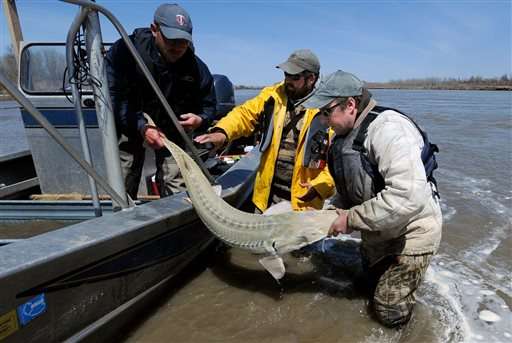In this 2014 photo, rom left, Montana Fish, Wildlife and Parks employees Dave Fuller, Chris Wesolek, and Matt Rugg release a pallid sturgeon after taking blood samples from the fish. U.S. officials will consider an alternative to a dam proposed on the Yellowstone River over worries it could hurt an endangered fish species that dates to the time of dinosaurs, after a judge on Tuesday, Jan. 5, 2016 approved a settlement in a lawsuit over the project. (James Woodcock/The Billings Gazette via AP)
U.S. officials will consider an alternative to a dam proposed on the Yellowstone River over worries it could hurt an endangered fish species that dates to the time of dinosaurs, after a judge on Tuesday approved a settlement in a lawsuit over the project.
The agreement comes after environmental groups successfully sued to stop the $59 million dam along the Yellowstone near the Montana-North Dakota border. It was signed by attorneys for the U.S. Army Corps of Engineers, the Fish and Wildlife Service and the Bureau of Reclamation.
U.S. District Judge Brian Morris issued an order putting the lawsuit on hold pending a new environmental study of the project to be completed by the end of 2016.
The low-profile, concrete dam was intended to replace a weir northeast of Glendive, Montana, that for more than a century has blocked about 125 endangered sturgeon from reaching their upstream spawning grounds. That weir, called the Intake Diversion Dam, is a porous, rock dam that diverts water for an irrigation system serving more than 50,000 acres of cropland in eastern Montana and western North Dakota.
Morris blocked construction of the new dam in September, just as work was set to begin. Attorneys for Defenders of Wildlife and the Natural Resources Defense Council had argued there was no proof a fish bypass channel included as part of the project would work.
Removing the dam would open up 165 river miles for sturgeon to spawn upstream of the existing weir.
"We're hoping the agencies take a real hard, realistic look at just taking that dam out of the river altogether," said McCrystie Adams, an attorney for Defenders of Wildlife. "There's no reason for that dam. You take out the dam, and you fix the problem."
Pallid sturgeon are known for a distinctive, long snout and can live 50 years, reaching 6 feet in length. Believed to date to the days when Tyrannosaurus Rex walked the Earth, the population declined sharply during the past century as dams were built along the Missouri River system. They were listed as an endangered species in 1990.
The sturgeon inhabiting the lower Yellowstone have been essentially trapped downstream of the rock weir since it was built in 1905. At least one female fish managed to swim around the structure during high water in 2014, but that was considered a rare occurrence.
The Bureau of Reclamation and Army Corps will take public comments for the next 45 days to determine the scope of their upcoming environmental study, including what alternatives will be considered. Whatever option is selected must balance mandatory protections for sturgeon under the Endangered Species Act with an irrigation project serving almost 400 farms that was authorized by Congress.
"You're trying to retrofit something that's 100 years-old for both the fish and the farmers," Reclamation spokesman Tyler Johnson said.
Three irrigation districts that would benefit from the project joined the case on the side of the government in June. They argued the dam and bypass would help sturgeon while protecting farms.
Those irrigators—the Savage Irrigation District, Intake Irrigation District and Lower Yellowstone Project—remain hesitant about removing the weir. It would require the installation of costly pumps and other equipment to keep water flowing to farmers, their attorney, Mark Stermitz, said Tuesday.
Nevertheless, Stermitz signed onto the agreement between the government and environmentalists. He said he did not want to undermine future discussions about the project by pre-judging the outcome of the new environmental study that's been ordered.
"We're not afraid of where the science takes us," he said. "We felt the government was correct in not considering (removing the weir), but we support the agreement and feel that it should get a fair hearing."
© 2016 The Associated Press. All rights reserved.



















